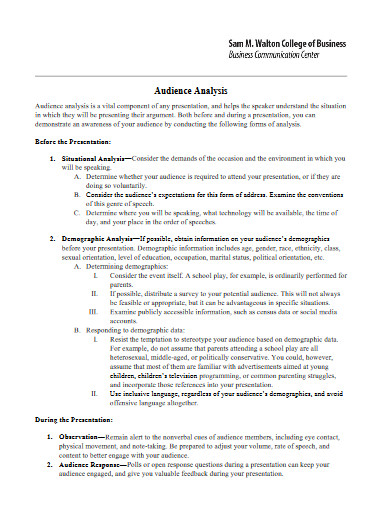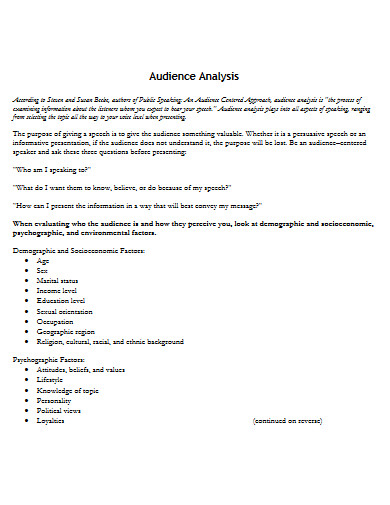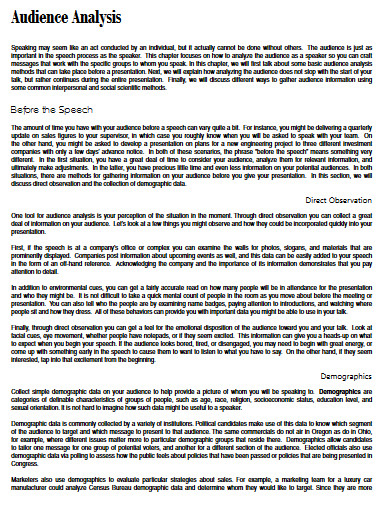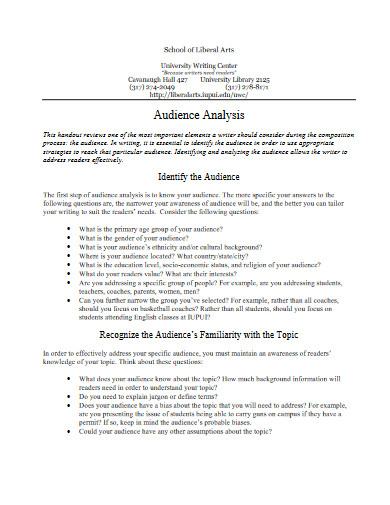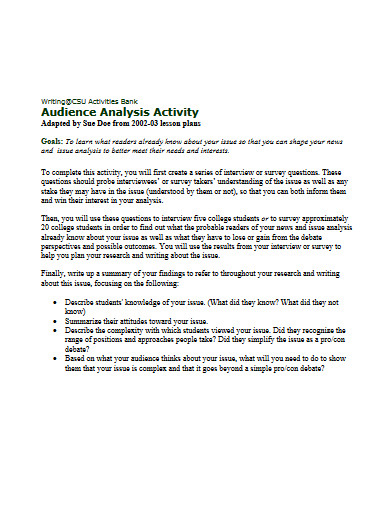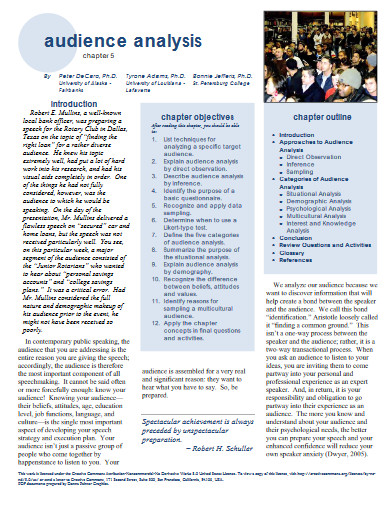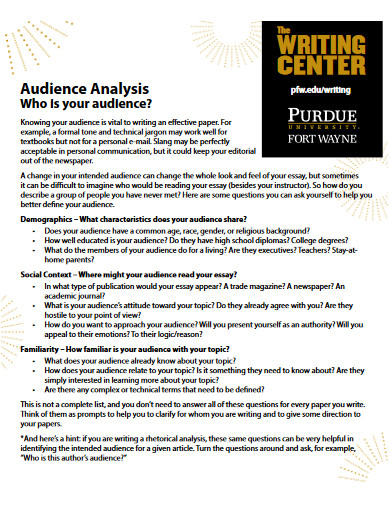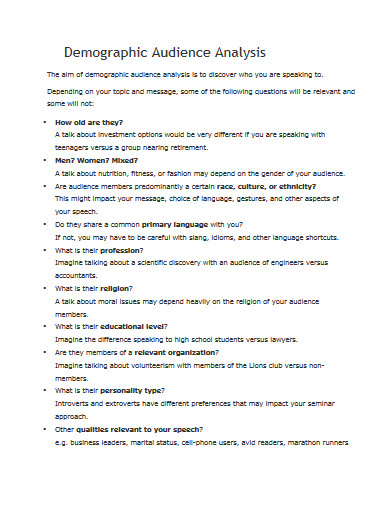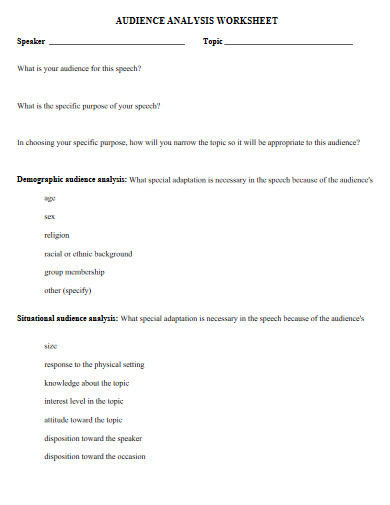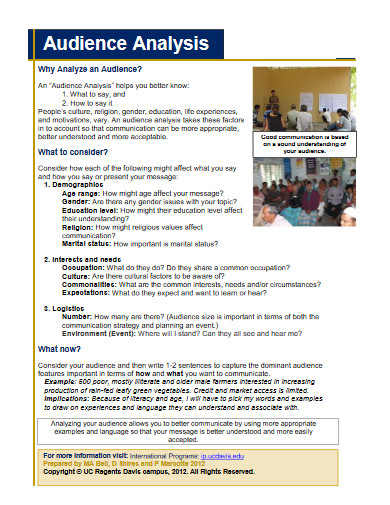10+ Audience Analysis Examples to Download
If you think establishing a business should solely focus on providing the best products and services, you’re missing several crucial points. Do the people want to have what’s on your racks? Will it appeal to them? How can you offer it to them? Be audience-centric. Take a big chunk of your business considerations from your audience’s insights through reliable audience analysis. This provides you with factual and dependable information that you can use to catch your market’s attention. You’ll be able to formulate a market report that gives a comprehensive detail of your audience’s needs and wants. Learn more about this through the article below.
10+ Audience Analysis Examples
1. Audience analysis Template

2. College Audience Analysis
3. Sample Audience Analysis
4. Audience Analysis Example
5. School Audience Analysis
6. Audience Analysis Activity
7. Basic Audience Analysis
8. University Audience Analysis
9. Demographic Audience Analysis
10. Audience Analysis Worksheet
11. Audience Analysis in PDF
What Is an Audience Analysis?
Audience analysis serves as an evaluation in identifying an audience’s preferences, personality, beliefs, expectations, values, and needs so you can formulate a message or content that appeals to them. This is an important marketing approach where the target market becomes the basis for every decision and strategy. This method is primarily used by writers, speakers, and content creators to ensure that they’re providing the right information that best fits their audience.
Look Out: Types of Target Audience You’ll Meet
Audience targeting is crucial in businesses because it provides businesses and content creators with a microscopic lens to assess their audience’s needs. It’s challenging to identify an entire crowd’s perspective. This is where tools such as target market analysis, audience survey, and audience mapping become handy. Picking out the “most likely” of those people who will pay attention to your content, products, and services set your focus and support your initiative to build actionable strategies.
To help identify them, here is the list of some types of target audience you’ll meet along the way:
1. Locations. These are audiences that you choose based on their address or location concerning your promotions.
2. Demographics. This type of audience divides the crowd according to age group.
3. Needs. These are audiences that you choose according to their needs (e.g., new mothers would buy milk bottles and other baby products)
4. Subculture. This is common in media entertainment where there’s a constant development of minor communities who share the same interests (e.g., artist fandoms)
5. Super culture. It’s similar among subculture, but this contains people who are inclined to a more generalized interest such as fishing, traveling, and collecting antiques.
6. Personality. This seeks people whose characteristics will more likely adopt certain products and content.
7. Attitude. These audiences possess or heed their brief in a way that affects their market decisions.
How to Make an Audience Analysis
According to the Medium, among the benefits of making an effort to know your audience is that it helps you spend your time and resources wisely and identify which market gaps your competitors failed to notice. The latter helps you become more competitive and strategic as you thrive in the industry. An audience analysis is a key tool in accomplishing that. Learn the following tips in making your own:
1. Have a Target Audience
To come up with a plan, identify what your most likely audience is going to be. Do this by logically assessing what you do and the kind of crowd that it can possibly gather. You don’t have to go into details just yet because you would be making assumptions. Provide general answers, such as office workers, students, or young children. For example, if you’re making a content article about business contracts, you might think of your writing for business people or technical writers who want to learn about it. This will serve as the basis for your analysis.
2. Establish What You Want to Know
There is so much that you can get out of your audience. You can learn about their food options, preferred destinations, or common beliefs. They have various characteristics and choices that make them unique and can help you understand them better. However, you don’t need to know everything about them. Determine what you know about them by referring it to your objective. For example, if you’re making a beauty product catalog for young adults, you might want to learn and make a list of the different types of product preference they all have in common and the trendy makeup style they generally prefer. This way, you’ll be gathering information that fulfills your goal.
3. Choose an Analysis Method
Your analysis method is how you plan to perform your data-gathering process. You can use direct observation and employ the power of social media firsthand to observe the preferences the drive your audience’s decisions. You can also take into account their environment and its existing values. If you want to get in-depth information, you can conduct focus group interviews or survey questionnaires. This way, you’ll be able to get quantifiable results that will be a significant basis for your strategies and content inclusions.
4. Complete an Audience Profile
Out of the results of your data-gathering, it’s time to establish your audience’s persona by creating an audience profile. This gathers everything that you’ve found out about your audience that’s relevant to your goal. This will serve as your future reference that will guide your transactions and activities such as business releases, marketing plan, and your product’s marketing roadmap, whichever applies to you. Don’t settle for your current copy and take the initiative to update it after a specific period. It’s inefficient to follow the same results when changes happen every day.
FAQs
What are the different types of audience analysis?
There are five types of audience analysis: demographics analysis, situational analysis, psychographic analysis, multicultural analysis, and topic interest analysis.
How do you describe a target audience?
According to Bizfluent, that characteristic of a target audience include demographics, purchase history, consumer attitude, and business consumers.
How do you define a primary target audience?
Primary target audiences are clients or customers who businesses consider to have the highest potential to patronize or simply avail their products and services.
The business congestion in the market makes it a challenging space to thrive in. If you want to stay in the competition, you must have a steady stream of customers to keep your brand operations alive. This is why audience analysis is crucial because paying constant attention to your market’s preferences allows you to craft promotions and offer deals that will attract their attention and satisfy their needs. Make use of this tool through our high-quality audience analysis template. Download now!



